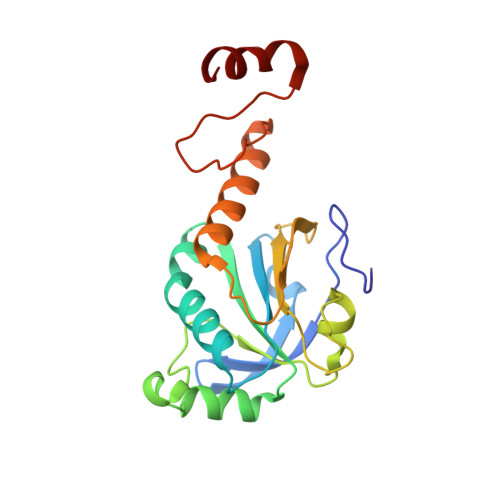Modifying the resolving cysteine affects the structure and hydrogen peroxide reactivity of peroxiredoxin 2.
Peskin, A.V., Meotti, F.C., Kean, K.M., Gobl, C., Peixoto, A.S., Pace, P.E., Horne, C.R., Heath, S.G., Crowther, J.M., Dobson, R.C.J., Karplus, P.A., Winterbourn, C.C.(2021) J Biological Chem 296: 100494-100494
- PubMed: 33667550
- DOI: https://doi.org/10.1016/j.jbc.2021.100494
- Primary Citation of Related Structures:
7KIZ, 7KJ0, 7KJ1 - PubMed Abstract:
Peroxiredoxin 2 (Prdx2) is a thiol peroxidase with an active site Cys (C52) that reacts rapidly with H 2 O 2 and other peroxides. The sulfenic acid product condenses with the resolving Cys (C172) to form a disulfide which is recycled by thioredoxin or GSH via mixed disulfide intermediates or undergoes hyperoxidation to the sulfinic acid. C172 lies near the C terminus, outside the active site. It is not established whether structural changes in this region, such as mixed disulfide formation, affect H 2 O 2 reactivity. To investigate, we designed mutants to cause minimal (C172S) or substantial (C172D and C172W) structural disruption. Stopped flow kinetics and mass spectrometry showed that mutation to Ser had minimal effect on rates of oxidation and hyperoxidation, whereas Asp and Trp decreased both by ∼100-fold. To relate to structural changes, we solved the crystal structures of reduced WT and C172S Prdx2. The WT structure is highly similar to that of the published hyperoxidized form. C172S is closely related but more flexible and as demonstrated by size exclusion chromatography and analytical ultracentrifugation, a weaker decamer. Size exclusion chromatography and analytical ultracentrifugation showed that the C172D and C172W mutants are also weaker decamers than WT, and small-angle X-ray scattering analysis indicated greater flexibility with partially unstructured regions consistent with C-terminal unfolding. We propose that these structural changes around C172 negatively impact the active site geometry to decrease reactivity with H 2 O 2 . This is relevant for Prdx turnover as intermediate mixed disulfides with C172 would also be disruptive and could potentially react with peroxides before resolution is complete.
- Department of Pathology and Biomedical Science, University of Otago Christchurch, Christchurch, New Zealand.
Organizational Affiliation:
















